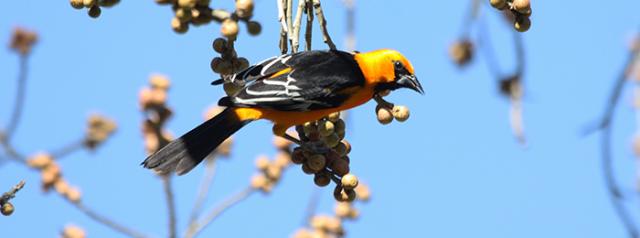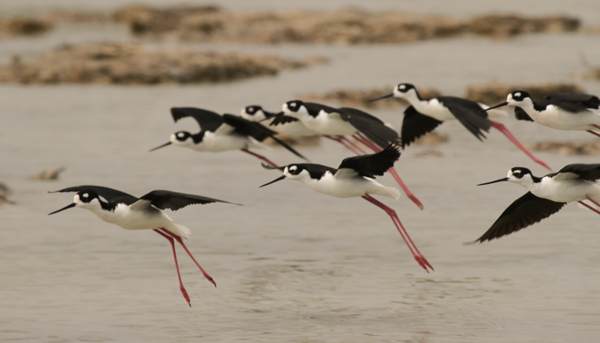The Holbrook Explorer

eBird for Beginners
eBird for Beginners
There are two special celebratory birding events every year, Global Big Day and the Christmas Bird Count, that were started by Audubon Society and the Cornell Lab of Ornithology to invite everyone from around the world to go out and record bird species they see using their eBird database. In turn, these community birding experiences provide valuable information to scientists about bird populations for research, conservation efforts, and education. For first-time participants, we're here to show you the basics of navigating your way around eBird mobile to help you have a successful day of birding.
What is it?
eBird is the Cornell Lab of Ornithology’s online database for all bird-watching data collected throughout the year by people around the world. It can be accessed via an online platform on a computer or through their free mobile app, which can be downloaded on Apple and Android smartphones. eBird Mobile makes it possible to collect and submit bird observations directly to eBird from the field. eBird Mobile passes your information from your iOS or Android device directly to your eBird account on the web, making it an easy and organized way to bird watch.

Black-necked Stilts
Photo by John Hannan
How do I use it?
Once you download the app, it’s time to set up your account and personalize your experience. After entering your information, you can customize your preferences, like language, unit of distance (metric or imperial), and whether you would prefer common names or scientific names to show up during data entry.
Once you have everything all set up, it’s time to start entering your sightings:
- Click “Start Checklist” on the bottom of the screen.
- Enter your location by choosing a point off the map. The GPS in your phone is used to determine where you are and deliver all the nearby eBird locations. From there you can either choose a pre-existing birding hotspot or make a new personal location if a point doesn’t already exist.
- After you've selected the location, you'll be taken to the Date & Time screen, where you can choose your start time for the checklist, the day, and turn on tracking, which allows the phone GPS to keep track of where and how far you travel as you bird.
- After establishing all of the background information, now it’s time for the fun part: logging the birds. A big perk of using eBird Mobile is its quick entry. Type in the number of birds from that species followed by the name or its four letter code in the search bar at the top. When the correct bird pops up, click to add it to your checklist. Once added, tap on a bird's name to enter comments about that sighting.
- When you're done, you can tap “Review & Submit” to be taken to the checked page. If you chose to allow tracking, the distance and duration of time you traveled will be automatically filled in. Just add the number of people in your birding group and you’re all set to hit submit! Once submitted, your checklist will be permanently in your account and used for research.

Source: eBird
Tips for eBird Mobile
TIP: Plan out the location(s) you want to bird at on May 4 ahead of time. It can be anywhere, from your favorite spot to someplace new. If you need help deciding where to go, you can check out the “Birding Hotspots” in your area already logged by other users as places with large bird populations.
TIP: Use SIRI or a voice-to-text feature on your smart phone when entering notes about bird species if the small phone screen is hard for you to type on.
TIP: It is highly recommended to turn on the tracking feature on your phone. It will give you a more precise measurement of how far you traveled and will make it easier for you to log.
TIP: As you become more experienced using the app, you can view your progress on the “My eBird” screen, which keeps track of all your lists and compares your sightings between years, letting you know how you’ve progressed over the years.
TIP: Make sure to submit your checklists as soon as possible, whether it’s out in the field or as soon as you get back home, because if something happens to your phone before it's submitted the data will be lost forever.
TIP: When you're out looking for birds, break up your birding into multiple checklists, splitting them up according to time of day (morning, afternoon, and night), different locations, or if you take a break and start birding again to provide more accurate information on what birds are occurring there at what time of day.
TIP: The best way to have an accurate and complete list is to keep track of the birds as you're seeing them rather than waiting to log them all at the end.

Blue-and-white Swallow
Photo by Sanford M. Sorkin
Why is it important?
The introduction of the eBird Mobile app has revolutionized the collection of biodiversity information worldwide, making it easier and faster than ever before. By always having a birding tool with you wherever you go, you are providing the most up-to-date information for researchers and conservationists to help their efforts in protecting declining populations, threatened and endangered bird species. Also, by making birding more accessible to people on a mobile platform, eBird is opening the doors for new people to be aware of and get involved with bird conservation efforts.



